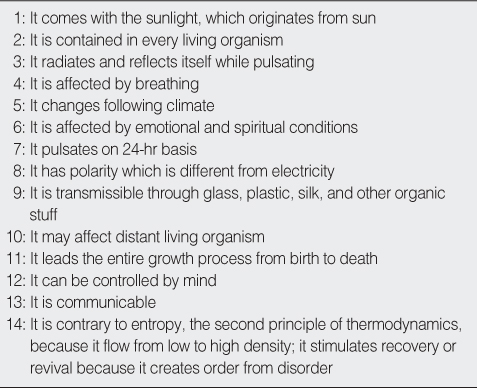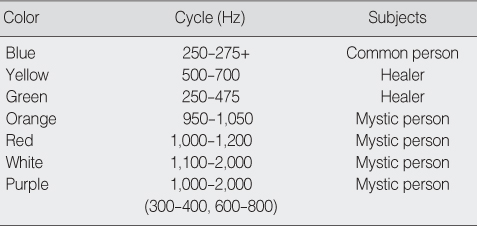Articles
- Page Path
- HOME > J Korean Acad Nurs > Volume 38(3); 2008 > Article
-
Original Article
- Understanding Qi: Its Development and Clinical Application to Nursing Practices
- Myungja Kim
-
Journal of Korean Academy of Nursing 2008;38(3):445-453.
DOI: https://doi.org/10.4040/jkan.2008.38.3.445
Published online: June 30, 2008
Professor, College of Nursing, The Catholic University of Korea, Seoul, Korea.
- Address reprint requests to: Kim, Myungja. College of Nursing, The Catholic University of Korea, 505 Banpo-dong, Seocho-gu, Seoul 137-040, Korea. Tel: 82-2-590-1284, Fax: 82-2-590-1297, mdja@catholic.ac.kr
• Received: February 5, 2008 • Accepted: May 23, 2008
Copyright © 2008 Korean Society of Nursing Science
- 535 Views
- 3 Download
Abstract
-
Purpose
- This paper analyzed the historical origins of the Qi concept and assesses its possible contributions to the development of complementary therapy and new nursing practices.
-
Methods
- In order to clarify the Qi concept and measure its theoretical/clinical potentials, this study analyzed both historical data and experimental research that adopt and apply the concept. These include modern/contemporary research measuring its effects in promoting mental and physical health. Using the method of cross-cultural comparison, this study analyzed diverse approaches to the Qi concept and sought to find common features among the approaches.
-
Results
- A historical, cross-cultural analysis revealed several fundamental similarities between Qi theories that have developed in the east and the holistic concepts that have evolved in the western traditions. Especially, the analysis of the more recent research on the Qi concept shows ample possibilities of its future contributions to the development of new diagnostic applications and the promotion of overall human health.
-
Conclusion
- The historical study of the Qi concept found some key common factors in the diverse philosophical traditions in the east and the west. Considering the growing popularity of complementary therapy among health professionals and the general public, the Qi concept and its clinical applications are expected to promote human health. In this context, this research contributes to developing new nursing practices based on the concept by clarifying its philosophical origins and theoretical backgrounds.
- 1. Bang GU. Qi/moral & science. 2005;Seoul, Yaein Publishing.
- 2. Brennan BA. Hands of light. 1987;New York, NY, Bantan Book.
- 3. Cho SH. Effects of moxibustion on physiological indices and autonomic nervous symptoms in adult with prehypertension. 2006;Seoul, The Catholic University of Korea. Unpublished doctoral dissertation.
- 4. Clark AM, Louis JV. Bioenergic medicine east and west. 1988;Berkeley, North Atlantic Books.
- 5. Cuema K. Kim MJ Jo KW . Nursing Theory of Japan. 1998;Seoul, Hyunmoon Publishing.
- 6. Dossey BM, Keegan L, Guzzetta CE, Kolkmeier LH. Holistic nursing: A handbook for practice. 1995;Gaithersburg, MD, Aspen.
- 7. Eisenberg DM, Davis RB, Ettner SL, Appel S, Wilkey S, Van Rompay M, et al. Trends in alternative medicine use in the United State, 1990-1997. The Journal of the American Medical Association. 1998;280:1569–1575.PubMed
- 8. Gerber R. Vibrational medicine. 1988;SantaFe, Bear & Comp.
- 9. Hunt VV. Infinite mind. Magical Blend, January. 1990;22–25.
- 10. Jang EH, Park KS. A comparative study of nurses and physicians' attitudes about complementary and alternative therapy. Journal of Korean Academy of Adult Nursing. 2003;15:402–410.
- 11. Jung UY. Development of Korean traditional medicine and prospective. The Third Medicine. 1996;1(2):57–82.
- 12. Kim BE, Lee HY. Effect of moxibustion on urinary incontinence in stroke patients. Journal of East-West Nursing Research. 2002;7:82–93.
- 13. Kim JE. Psychology of Qi. 1996;Seoul, Ewha Woman's University Press.
- 14. Kim JH. Reviving your Qi with meditation. The Yonsei Chunchu, 1561. 2007;03 26 Retrieved May 25, 2008. from http://chunchu.yonsei.ac.kr/news/articleView.html?idxno=9909#.
- 15. Kim MJ, Lee MS. Nursing approach to energy (Qi) flow. Journal of East-West Nursing Research. 1998;3:7–16.
- 16. Kim SO, Cho SH. Effect of Koryo Hand Therapy and moxibustion on menstrual problems. Journal of Korean Academy of Women's Health Nursing,. 2001;7:610–621.
- 17. Kim YG, Lee HY. The effectiveness of meridian acupressure intervention using sticker needles to bowel movement on post spinal operative patients. Journal of East-West Nursing Research. 2005;11:33–41.
- 18. Krieger D. Accepting your power to heal: Therapeutic touch. 1993;Santafe, Bear & Co..
- 19. Lee DH. The Korean healing art of Yakson. 2003;Seoul, Mind world Publishing.
- 20. Lee HY, Cho KJ, Kang HS, Shin HS. Research trend of oriental nursing in Korea. Journal of East-West Nursing Research. 2003;8:27–40.
- 21. Lee MK. Effects of San-Yin-Jian (SP6) acupressure on anxiety, pulse and neonatal status in women during labor. Korean Journal of Women's Health Nursing. 2003;9:138–151.
- 22. Sancier KM. Medical applications of Qigong. Alternative Therapies in Health and Medicine. 1996;2:40–46.
- 23. Sancier KM, Hu B. Effects of Qigong and emitted Qi on humans, animals, cell cultures and plants: Review of selected scientific research. American Journal of Acupuncture. 1991;19:367–377.
- 24. Schlebusch KP, Maric-Oehler W, Popp FA. Biophotonics in the infrared spectral range reveal acupuncture meridian structure of the body. Journal of Alternative and Complementary Medicine. 2005;11:171–173.ArticlePubMed
- 25. Snyder M, Lindquist R. Complementary/alternative therapies in nursing. 2002;4th. ed.New York, Springer Publishing.
- 26. Sohn BD. Gudang acupucture and moxibustion. 2004;Seoul, Institute of Acupuncture and Moxibustion.
- 27. Wilber K. A brief history of everything. 1996;Boston & London, Shambhala.
- 28. Yasji M. Kim SI . Basic of the music therapy. 2003;Seoul, SamHo Music.
- 29. Unlicensed shaman-acupuncturist arrested. Yonhap News Agency. 2006;09 20 Retrieved December 20, 2007. from http://www.donga.com/fbin/output?sfrm=1&f=total&&n=200609260451.
- 30. Yuasa Y. Sohn BG . Qi and human science. 1992;Seoul, Rye-kang Publishing.
REFERENCES
Figure & Data
REFERENCES
Citations
Citations to this article as recorded by 

Understanding Qi: Its Development and Clinical Application to Nursing Practices
Understanding Qi: Its Development and Clinical Application to Nursing Practices
Characteristics of Bio-Energy
Various Name about Qi
Color and Cycle of Human Energy Field (Hunt, 1990)
Table 1
Characteristics of Bio-Energy
Table 2
Various Name about Qi
Table 3
Color and Cycle of Human Energy Field (Hunt, 1990)
 KSNS
KSNS
 E-SUBMISSION
E-SUBMISSION



 Cite
Cite

